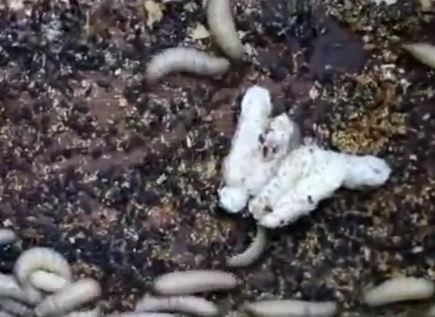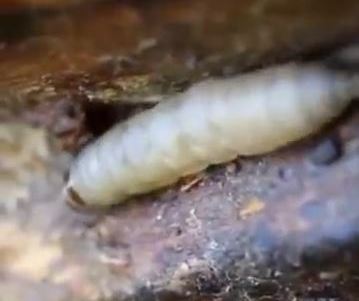Large wax moth - bee moth - a valuable beekeeping product

The large wax moth, also known as the bee moth (lat. Galleria mellonella), is a butterfly that belongs to the moth family.
Content
- Large wax moth - bee moth
- What does a wax moth look like?
- Wax moth benefits and harm
- Wax moth harm
- Wax moth benefits
Large wax moth - bee moth
The large wax moth, also known as the bee moth, is a malicious pest of honey bees. The large wax moth is found everywhere in areas where beekeeping is developed. Wax moth can also be called a small wax moth, or a small bee moth (Achroia grisella, which may have other names such as bee moth, clochen, wax moth, bloodworm). Wax moth larvae cause great harm to beekeeping, but at the same time they are a valuable beekeeping product. Wax moth larvae are widely used in a variety of areas of human activity, but wax moth larvae are especially widely used in apitherapy and pharmaceuticals.
These materials may be of interest to you
| How to breed wax moths in an apiary |
| Wax moth tincture for use in various diseases |
| How to prepare bee moth tincture |
| Bee moth contraindications for use |
What does a wax moth look like?
So, what does a wax moth look like, also known as a bee moth? The length of a bee moth butterfly or large wax moth is 1.8-3.8 cm. Its front wings are brown-grayish in color with a brown-yellow rear edge and there are dark spots on the wings. The hind wings of the wax moth are lighter. The wings are arranged cosmopolitanly. Wax moth or bee moth caterpillars live in honey bee hives and eat the wax from the honeycombs. The bottom of a beehive, strewn with wax crumbs and various bee debris, is ideal for the development of large wax moths; there are also many wax moth eggs on the honeycomb. In wax moths, adult moths do not feed because their mouthparts and other digestive organs are underdeveloped. Eggs of wax moths or bee moths have a whitish color, eggs measuring 0.35 by 0.5 mm, the egg development cycle lasts 5-8 days. Wax moth larvae emerge from the eggs, only 1 mm long with a yellowish head and 8 legs. Over time, wax moth larvae grow into caterpillars and reach a length of 18 mm with a brownish head.

butterfly and wax moth larvae
After 25-30 days, the wax moth caterpillars pupate; to do this, they find a crack; the crack can sometimes gnaw out a hole in the bottom of the hive. During maturation, wax moth pupae change in color from yellow to brown (females are approximately 16 mm long, males are approximately 14 mm long). Adult wax moth butterflies do not live long, 7-12 days for females and 10-26 days for males.
Wax moth benefits and harm
Wax moth harm
An adult wax moth butterfly causes significant harm to beekeeping. At the beginning of its development on wax honeycombs, the wax moth caterpillar feeds on honey and beebread. Next, the wax moth larvae proceed to feed on wax from the honeycomb, the wax moth larvae crawl forward, eating everything - the remains of cocoons mixed with wax, gnaws passages in the honeycombs, damaging the wings and legs of the bee brood. Wax moth larvae cover their passages with silk webs. When wax moth larvae have multiplied greatly, they damage the honeycombs, as well as the brood, honey reserves, beebread, the frames themselves and the insulation of the hives. When the hive is very badly damaged, wax moth larvae begin to eat each other and the droppings of previous generations of larvae. In this case, the bee colonies become very weak and may die, but more often the bees leave their hive, forming a so-called swarm out of necessity.
 wax moth larva
wax moth larva
In order to imagine the harm that wax moth larvae cause to bees, it is enough to say that during the period of its development, one wax moth larva can destroy several hundred bee cells.
Wax moth benefits
However, despite the harm that wax moth larvae cause to bee colonies, wax moth larvae are a very valuable beekeeping product, which every year finds its application in a variety of applications.
- Firstly, wax moth larvae have found use in medicine; tincture of wax moth larvae is the simplest and most affordable medicine that has a whole range of useful properties. Also, many medicines are prepared based on wax moth larvae, so the extract of wax moth larvae is used in the treatment of many diseases.
- A whole line of medicines has also been created in the form of tablets, ointments, suppositories using extract of wax moth larvae.
- Medicines based on wax moth larvae are easy to prepare yourself; wax moth tincture, for example, is very simple to prepare. Wax moth tincture preparation of bee moth tincture.
- How to use wax moth tincture can be found in the article How to use wax moth tincture.
- Wax moth is used to treat so many diseases that you can read it in full in the article wax mole application in medicine.
- But the large wax moth or bee moth is very widely used for various scientific and industrial purposes. For example, in the northern states of the United States and in European countries, wax moth larvae are grown commercially to be sold as bait to fishermen.
- In many countries, wax moth larvae are used as food for ornamental and exotic species of birds and amphibians (such as newts, toads, frogs, etc.) and reptiles (lizards, snakes, etc.).
- A number of scientists, due to the fact that wax moth larvae contain large amounts of proteins and fats, consider them as an alternative source of food.
- In addition, wax moth larvae are often bred in laboratories as a model object for biochemical and physiological studies, test objects for assessing the quality and activity of bacterial preparations, and also as food or as a host for entomophages (predatory bugs, Trichogramma, tachine flies etc.) for biologization of forestry and agriculture.
- Wax moth larvae can be raw materials for the production of chitosan and chitin.
- Wax moth larvae also find unexpected uses. For example, to solve the global problem of plastic waste accumulation. Landfills are filled with millions of tons of plastic, the air is polluted when this plastic is burned, and an entire continent of garbage has already formed in the Pacific Ocean, the area of which has exceeded 1,000,000 sq. km. Under the influence of sunlight, polymers decompose into microparticles, which subsequently adsorb various harmful impurities and are then integrated into the food chain. Wax moth larvae are promising for processing finely dispersed waste - these are the so-called “tails” that are formed when sorting plastic and are practically not used in any way.
- Wax moth larvae are also useful for beekeepers. Wax moth larvae are a valuable beekeeping product that can increase the profitability of an apiary and help the beekeeper maintain his health and the health of his family. And so on in detail, if you need to clean plastic bowls of wax, you can simply put them for a day with the wax moth larvae and they will polish the bowls themselves and they will be ready for reuse.
- Breeding wax moth larvae in an apiary as a beekeeping product is very simple; the technology and experience of beekeepers can be found in the article - how to breed wax moths.
